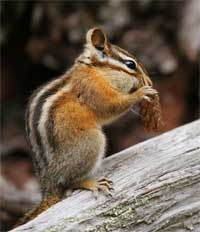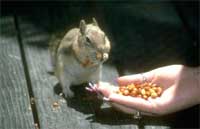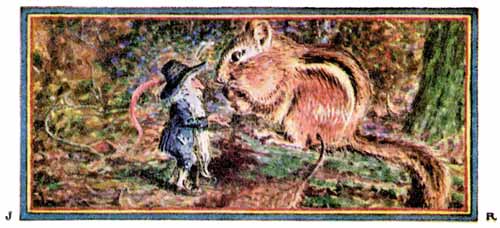
 Chipmunk Chews: Though they are commonly depicted with their paws up to the mouth, eating peanuts, or more famously their cheeks bulging out on either side, chipmunks eat a much more diverse range of foods than just nuts. Chipmunk Chews: Though they are commonly depicted with their paws up to the mouth, eating peanuts, or more famously their cheeks bulging out on either side, chipmunks eat a much more diverse range of foods than just nuts.
Their omnivorous diet consists of grain, nuts, birds' eggs, fungi, worms, and insects. Come autumn, many species of chipmunk begin to stockpile these goods in their burrows, for winter. Other species make multiple small caches of food. These two kinds of behavior are called larder hoarding and scatter hoarding. Larder hoarders usually live in their nests until spring.
Ecological Roles: These small squirrels fulfill several important functions in forest ecosystems. Their activities with regards to harvesting and hoarding tree seeds play a crucial role in seedling establishment. They also consume many different kinds of fungi, including those involved in symbiotic mycorrhizal associations with trees, and are an important vector for dispersal of the spores of subterranean sporocarps (truffles) which have co-evolved with these and other mycophagous mammals and thus lost the ability to disperse their spores through the air.
Tiny Predators: Chipmunks play an important role as prey for various predatory mammals and birds, but are also opportunistic predators themselves, particularly with regard to bird eggs and nestlings. In Oregon, Mountain Bluebirds (Siala currucoides) have been observed energetically mobbing chipmunks that they see near their nest trees.
 Hand Feeding: If unmolested they often become bold enough to accept food from the hands of humans. The temptation to pick up or pet any wild animal should be strictly avoided. While rabies is exceptionally rare, if not non-existent, in rodents, chipmunk bites can transmit virulent and dangerous bacterial infections. Hand Feeding: If unmolested they often become bold enough to accept food from the hands of humans. The temptation to pick up or pet any wild animal should be strictly avoided. While rabies is exceptionally rare, if not non-existent, in rodents, chipmunk bites can transmit virulent and dangerous bacterial infections.
Beautiful Burrows: Chipmunks construct expansive burrows which can be more than 3.5 m in length with several well-concealed entrances. The sleeping quarters are kept extremely clean as shells and feces are stored in refuse tunnels.

They Grow Up So Fast: Eastern chipmunks mate in early spring and again in early summer to produce two litters, each of four to five young, but western chipmunks only breed once a year. The young emerge from the burrow after about six weeks and strike out on their own within the next two weeks.

All text is available under the terms
of the GNU Free Documentation License
|